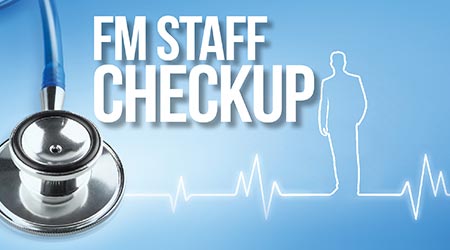Is It Time For A Facilities Management Staff Check-Up?
Don't get so caught up in KPIs that you let the facilities management department flatline.
The focused facility manager concentrates on keeping pace with corporate directives and meeting performance metrics. These directives and performance metrics drive the department’s success in terms of stature in the corporate environment as well as satisfaction ratings from customers, which, in turn, impact funding decisions by senior executives.
Sometimes, however, facility managers are so caught up in key performance indicators (KPI) and the business bottom line they fail to realize their department’s culture is suffering from health symptoms that may lead to a full-blown illness. In short, they fail to perform a periodic checkup on their department to see if there is need for preventive action to guarantee its continued wellness.
Time for a checkup?
Facility managers who fail to recognize their department’s symptoms typically say they are fully aware of what is happening in their organization and don’t need to stop their all-consuming daily business to perform a health checkup. Hidden but telltale signs, however, often indicate that facility departments may not be quite as healthy as their managers think. When these symptoms are left unchecked, these departments may end up with a debilitating illness. Consider these symptoms:
Staff are late to meetings and are reluctant to contribute. Staff become habitually late for meetings over time. They straggle in as if they really don’t want to attend. Participation in meetings seems like a chore rather than a positive team-related activity. During meetings, staff appear hesitant to make a contribution, unless they are called upon specifically.
Staff withhold information and aren’t interacting on a regular basis. Hoarding information becomes power, and operating in an “open book” environment no longer is the standard practice. Staff hole up in their private offices and cubicles, preferring to communicate via their computers and cell phones, rather than dropping in on each other to discuss issues in person.
Staff form small splinter groups. Cliques and cabals develop among the staff. Camaraderie is not as high as it used to be, and small groups start having their own meetings and socializing together to the exclusion of others.
Staff has little investment in organization goals. Interest in moving the organization towards established goals begins to wane. Staff are more interested in pursuing objectives that serve individual purposes, rather than the organization as a whole.
Staff cast blame when a crisis occurs. To the surprise of others, staff starts pointing fingers at one another when something goes wrong. In extreme cases, staff may even point a finger at a facility management colleague in front of a customer when there is a service problem.
Staff start retiring at a higher rate, and filling vacancies internally is problematic. Staff who once were quoted as saying they wanted to work as long as they could, all of a sudden begin exploring retirement options. When vacancies occur, very few internal candidates apply for positions, which forces most of the recruitment from external sources.
Customer complaints escalate at an alarming rate. At one time the facility department was known for exemplary customer service and achieving high satisfaction marks. Gradually, complaints about service become the norm and problems routinely are escalated to higher levels within the company.
Senior management complains about the facility department’s lack of attentiveness. Senior management notices the decline in customer satisfaction and reports facility staff behavior as less than attentive to problem resolution.
Project timelines start slipping. Deadlines and schedules slip and it is difficult to get facility projects back on track.
Learning is difficult, and feedback is non-existent. Staff find it difficult to learn new tools and techniques. They resist training, claiming they are too busy to attend sessions. They complain to each other, but do not provide feedback to their supervisors.
Tradition prevails over performance, benchmarks, and metrics. Staff adopt an attitude of “we have always done it this way,” and there is push-back each time an innovative or different approach to service delivery is introduced. Staff are slow to accept performance metrics and benchmarks, and they see little value in sharing industry best practices.
Minimizing risk becomes paramount. For years the department had a reputation for cutting-edge thinking and risk-taking. That reputation dwindles as staff begin to fear reprisals and start taking “safe” approaches to performing their work.
Related Topics:
















